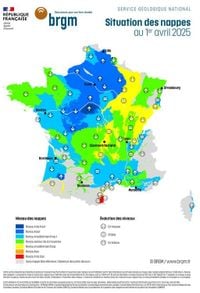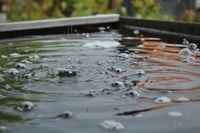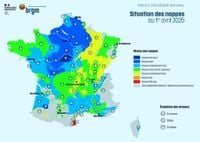As of April 1, 2025, groundwater levels across France are predominantly above normal, but concerns loom regarding potential summer droughts in certain regions, as reported by the Bureau de Recherches Géologiques et Minières (BRGM) on April 16, 2025. The latest data indicates that 52% of the country’s underground reserves are above normal levels, while 27% are below, and 20% are within the average range. This marks a decline from March 1, when 60% of groundwater levels were considered above average, and is also less favorable than the same time last year when 58% exceeded normal levels.
The BRGM attributes this decline to a premature drainage of groundwater, which has been exacerbated by rainfall deficits observed in February and March. Only the Southeast region, including Corsica, Côte d'Azur, Provence, and some valleys of Hérault, has experienced significant rainfall recently, leading to an increase in groundwater levels that has helped alleviate some of the deficits accumulated over the past months.
Despite these positive developments in the Southeast, regions such as the Corbières massif and the Roussillon plain continue to face critically low groundwater levels after nearly three years of drought. The BRGM warns that these areas will likely encounter restrictions on water usage in the coming months, as the summer forecasts remain pessimistic.
Looking ahead, the BRGM expresses a cautious optimism for the rest of France, particularly for the Paris Basin and parts of Artois, where substantial groundwater recharge occurred during the wet autumn and winter months. This recharge is expected to sustain adequate groundwater levels despite the onset of spring and the growing vegetation that will absorb much of the incoming rainfall.
However, Météo France has predicted above-normal temperatures for the April to June period, coupled with uncertain rainfall, which raises concerns for the groundwater in regions such as Sundgau in southern Alsace, the Rhône-Saône corridor, and parts of the Berry, Poitou, and the Armorican Massif. While recent rains offer some hope, a dry spring along with increased water withdrawals for agriculture and tourism could create tensions in water reserves.
Violaine Bault, a hydrogeologist at the BRGM, noted, "The situation remains satisfactory for most of the country, but we must remain vigilant, especially in areas like the Pyrénées-Orientales and the Corbières massif, where groundwater levels are still alarmingly low and may lead to a semi-desert climate if conditions do not improve."
The BRGM also highlighted that the groundwater recharge has been less effective in some regions due to the soil’s capacity to absorb rainfall, which is hindered by the resurgence of vegetation. This situation complicates the recharge process, particularly in areas that are not accustomed to prolonged dry spells.
As of April 1, 2025, the groundwater levels show that 49% are decreasing, a notable increase from 29% in February. The hydrological situation is mixed, with 27% of observation points reporting below-normal levels, while 12% are at very high levels. The overall trend is less favorable than in March 2024, when a larger percentage of groundwater levels were above normal.
For the remainder of the country, the BRGM remains cautiously optimistic, especially for the inertial groundwater in the Paris Basin, which is less reactive to short-term weather changes and is expected to maintain its levels through the summer. In contrast, regions with more reactive groundwater systems, such as those in the Sundgau and Rhône-Saône areas, may face challenges if the predicted dry conditions materialize.
In summary, while the groundwater situation in France is generally favorable as of early April 2025, significant uncertainties remain, particularly for the summer months. The BRGM's forecasts highlight the necessity for continued water conservation efforts and careful monitoring of groundwater levels as the country moves into a potentially dry season.
As the situation evolves, the BRGM will continue to publish monthly updates on groundwater levels, with the next report scheduled for mid-May 2025. This ongoing monitoring is crucial, as groundwater is a vital resource, accounting for nearly two-thirds of drinking water consumption and over a third of agricultural water use in France.








